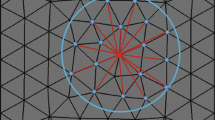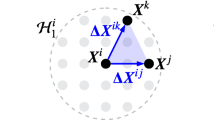Abstract
We introduce a framework for modeling dynamic fracture problems using cohesive polygonal finite elements. Random polygonal meshes provide a robust, efficient method for generating an unbiased network of fracture surfaces. Further, these meshes have more facets per element than standard triangle or quadrilateral meshes, providing more possible facets per element to insert cohesive surfaces. This property of polygonal meshes is advantageous for the modeling of pervasive fracture. We use both Wachspress and maximum entropy shape functions to form a finite element basis over the polygons. Fracture surfaces are captured through dynamically inserted cohesive zone elements at facets between the polygons in the mesh. Contact is enforced through a penalty method that is applied to both closed cohesive surfaces and general interpenetration of two polygonal elements. Several numerical examples are presented that illustrate the capabilities of the method and demonstrate convergence of solutions.


























Similar content being viewed by others
References
Abdelkader A, Mahmoud AH, Rushdi AA, Mitchell SA, Owens JD, Ebeida MS (2017) A constrained resampling strategy for mesh improvement. Comput Graph Forum 36(5):189–201
Anisimov D (2017) Barycentric coordinates and their properties. In: Hormann K, Sukumar N (eds) Generalized barycentric coordinates in computer graphics and computational mechanics. Taylor & Francis, CRC Press, Boca Raton, pp 3–22
Arroyo M, Ortiz M (2006) Local maximum-entropy approximation schemes: a seamless bridge between finite elements and meshfree methods. Int J Numer Methods Eng 65(13):2167–2202
Barenblatt GI (1962) The mathematical theory of equilibrium cracks in brittle fracture. Adv Appl Mech 7:55–129
Beirão da Veiga L, Brezzi F, Cangiani A, Manzini G, Marini LD, Russo A (2013) Basic principles of virtual element methods. Math Models Methods Appl Sci 23(1):199–214
Belytschko T, Krongauz Y, Organ D, Fleming M, Krysl P (1996) Meshless methods: an overview and recent developments. Comput Methods Appl Mech Eng 139(1–4):3–47
Belytschko T, Liu WK, Moran B, Elkhodary K (2013) Nonlinear finite elements for continua and structures, 2nd edn. Wiley, Chichester
Bishop JE (2009) Simulating the pervasive fracture of materials and structures using randomly close packed Voronoi tessellations. Comput Mech 44(4):455–471
Bishop JE (2014) A displacement-based finite element formulation for general polyhedra using harmonic shape functions. Int J Numer Methods Eng 97(1):1–31
Bobaru F, Zhang G (2015) Why do cracks branch? A peridynamic investigation of dynamic brittle fracture. Int J Fract 196:59–98
Bolander JE, Saito S (1998) Fracture analyses using spring networks with random geometry. Eng Fract Mech 61(5):569–591
Borden MJ, Verhoosel CV, Scott MA, Hughes TJR, Landis CM (2012) A phase-field description of dynamic brittle fracture. Comput Methods Appl Mech Eng 217:77–95
Camacho GT, Ortiz M (1996) Computational modelling of impact damage in brittle materials. Int J Solids Struct 33(20–22):2899–2938
Chen J-S, Wu C-T, Yoon S, You Y (2001) A stabilized conforming nodal integration for Galerkin mesh-free methods. Int J Numer Methods Eng 50(2):435–466
Congleton J, Petch NJ (1967) Crack-branching. Philos Mag 16(142):749–760
Dijkstra EW (1959) A note on two problems in connexion with graphs. Numer Math 1(1):269–271
Dugdale DS (1960) Yielding of steel sheets containing slits. J Mech Phys Solids 8:100–104
Dunavant DA (1985) High degree efficient symmetrical Gaussian quadrature rules for the triangle. Int J Numer Methods Eng 21(6):1129–1148
Ebeida MS, Davidson AA, Patney A, Knupp PM, Mitchell SA, Owens JD (2011) Efficient maximal Poisson-disk sampling. ACM Trans Graph 30(4):49–60
Ericson C (2005) Real-time collision detection. CRC Press, Boca Raton
Floater MS (2015) Generalized barycentric coordinates and applications. Acta Numer 24:161–214
Floater MS, Gillette A, Sukumar N (2014) Gradient bounds for Wachspress coordinates on polytopes. SIAM J Numer Anal 52(1):515–532
Francfort GA, Marigo J (1998) Revisiting brittle fracture as an energy minimization problem. J Mech Phys Solids 46(8):1319–1342
Gamito MN, Maddock SC (2009) Accurate multidimensional Poisson-disk sampling. ACM Trans Graph 29(1):8–26
Garimella RV (2002) Mesh data structure selection for mesh generation and FEA applications. Int J Numer Methods Eng 55(4):451–478
Green AK, Pratt PL (1974) Measurement of the dynamic fracture toughness of polymethylmethacrylate by high-speed photography. Eng Fract Mech 6:71–80
Ha YD, Bobaru F (2010) Studies of dynamic crack propagation and crack branching with peridynamics. Int J Fract 162(1):229–244
Hawong JS, Kobayashi AS, Dadkhah MS, Kang BS-J, Ramulu M (1987) Dynamic crack curving and branching under biaxial loading. Exp Mech 27:146–153
Hinton E, Rock T, Zienkiewicz OC (1976) A note on mass lumping and related processes in the finite element method. Earthq Eng Struct Dyn 4(3):245–249
Hofacker M, Miehe C (2013) A phase field model of dynamic fracture: robust field updates for the analysis of complex crack patterns. Int J Numer Methods Eng 93(3):276–301
Hormann K, Sukumar N (2008) Maximum entropy coordinates for arbitrary polytopes. Comput Graph Forum 27(5):1513–1520
Hughes TJR (2000) The finite element method: linear static and dynamic finite element analysis. Dover, Mineola
Jaynes ET (1957) Information theory and statistical mechanics. Phys Rev 106(4):620
Kalthoff JF, Winkler S (1987) Failure mode transition at high rates of shear loading. In: Chiem CY, Kunze HD, Meyer LW (eds) International conference on impact loading and dynamic behavior of materials, vol 1, pp 185–195
Kalthoff JF (2000) Modes of dynamic shear failure in solids. Int J Fract 101(1):1–31
Kim K, Bolander JE, Lim YM (2013) Failure simulation of RC structures under highly dynamic conditions using random lattice models. Comput Struct 125:127–136
Kobayashi AS, Wade BG, Bradley WB, Chiu ST (1974) Crack branching in Homalite-100 sheets. Eng Fract Mech 6(1):81–92
Krongauz Y, Belytschko T (1997) Consistent pseudo-derivatives in meshless methods. Comput Methods Appl Mech Eng 146(3–4):371–386
Kullback S, Leibler RA (1951) On information and sufficiency. Ann Math Stat 22(1):79–86
Leon SE, Spring DW, Paulino GH (2014) Reduction in mesh bias for dynamic fracture using adaptive splitting of polygonal finite elements. Int J Numer Methods Eng 100(8):555–576
Li S, Liu WK, Rosakis AJ, Belytschko T, Hao W (2002) Mesh-free Galerkin simulations of dynamic shear band propagation and failure mode transition. Int J Solids Struct 39(5):1213–1240
Millán D, Sukumar N, Arroyo M (2015) Cell-based maximum-entropy approximants. Comput Methods Appl Mech Eng 284:712–731
Moës N, Belytschko T (2002) Extended finite element method for cohesive crack growth. Eng Fract Mech 69(7):813–833
Mousavi SE, Xiao H, Sukumar N (2010) Generalized Gaussian quadrature rules on arbitrary polygons. Int J Numer Methods Eng 82:99–113
Papoulia KD, Vavasis SA, Ganguly P (2006) Spatial convergence of crack nucleation using a cohesive finite-element model on a pinwheel-based mesh. Int J Numer Methods Eng 67:1–16
Park K, Paulino GH (2013) Cohesive zone models: a critical review of traction–separation relationships across fracture surfaces. Appl Mech Rev 64(6):060802
Paulino GH, Celes W, Espinha R, Zhang Z (2008) A general topology-based framework for adaptive insertion of cohesive elements in finite element meshes. Eng Comput 24:59–78
Radovitzky R, Seagraves A, Tupek M, Noels L (2011) A scalable 3D fracture and fragmentation algorithm based on a hybrid, discontinuous Galerkin, cohesive element method. Comput Methods Appl Mech Eng 200(1–4):326–344
Ramulu M, Kobayashi AS (1985) Mechanics of crack curving and branching—a dynamic fracture analysis. Int J Fract 27(3):187–201
Ravi-Chandar K (1998) Dynamic fracture of nominally brittle materials. Int J Fract 90(1–2):83–102
Ravi-Chandar K, Knauss WG (1982) Dynamic crack-tip stresses under stress wave loading—a comparison of theory and experiment. Int J Fract 20:202–209
Ravi-Chandar K, Knauss WG (1984a) An experimental investigation into dynamic fracture: I. Crack initiation and arrest. Int J Fract 25(4):247–262
Ravi-Chandar K, Knauss WG (1984b) An experimental investigation into dynamic fracture: III. On steady-state crack propagation and crack branching. Int J Fract 26:141–154
Rimoli JJ, Rojas JJ (2015) Meshing strategies for the alleviation of mesh-induced effects in cohesive element models. Int J Fract 193:29–42
Rittel D, Maigre H (1996) An investigation of dynamic crack initiation in PMMA. Mech Mater 23(3):229–239
Shannon CE (1948) A mathematical theory of communication, part I, part II. Bell Syst Tech J 27:623–656
Sharon E, Fineberg J (1996) Microbranching instability and the dynamic fracture of brittle materials. Phys Rev B 54(10):7128–7139
Sharon E, Gross SP, Fineberg J (1995) Local crack branching as a mechanism for instability in dynamic fracture. Phys Rev Lett 74(25):5096–5099
Sieger D, Alliez P, Botsch M (2010) Optimizing Voronoi diagrams for polygonal finite element computations. In: Shontz S (ed) Proceedings of the 19th international meshing roundtable, pp 335–350
Silling SA (2003) Dynamic fracture modeling with a meshfree peridynamic code. In: Bathe KJ (ed) Proceedings second MIT conference on computational fluid and solid mechanics, pp 641–644
Song J-H, Wang H, Belytschko T (2008) A comparative study on finite element methods for dynamic fracture. Comput Mech 42(2):239–250
Spring DW, Paulino GH (2018) Achieving pervasive fracture and fragmentation in three-dimensions: an unstructuring-based approach. Int J Fract 210:113–136
Spring DW, Leon SE, Paulino GH (2014) Unstructured polygonal meshes with adaptive refinement for the numerical simulation of dynamic cohesive fracture. Int J Fract 189:33–57
Sukumar N (2004) Construction of polygonal interpolants: a maximum entropy approach. Int J Numer Methods Eng 61(12):2159–2181
Sukumar N (2013) Quadratic maximum-entropy serendipity shape functions for arbitrary planar polygons. Comput Methods Appl Mech Eng 263:27–41
Sukumar N, Wright RW (2007) Overview and construction of meshfree basis functions: from moving least squares to entropy approximants. Int J Numer Methods Eng 70(2):181–205
Talischi C, Paulino GH (2014) Addressing integration error for polygonal finite elements through polynomial projections: a patch test connection. Math Models Methods Appl Sci 24(8):1701–1727
Talischi C, Paulino GH, Pereira A, Menezes IFM (2012) PolyMesher: a general-purpose mesh generator for polygonal elements written in Matlab. Struct Multidiscipl Optim 45(3):309–328
Talischi C, Pereira A, Menezes IFM, Paulino GH (2015) Gradient correction for polygonal and polyhedral finite elements. Int J Numer Methods Eng 102(3–4):728–747
Taylor LM, Flanagan DP (1986) PRONTO 2D: a two-dimensional transient solid dynamics program. Technical report SAND-86-0594, Sandia National Laboratories, Albuquerque, New Mexico
van den Bergen G (2004) Collision detection in interactive 3D environments. Morgan Kaufmann Series in Interactive 3D Technology. San Francisco: Morgan Kaufmann
Wachspress EL (1975) A rational finite element basis. Academic Press, New York
Wriggers P, Reddy BD, Rust W, Hudobivnik B (2017) Efficient virtual element formulations for compressible and incompressible finite deformations. Comput Mech 60(2):253–268
Xu X, Needleman A (1994) Numerical simulations of fast crack growth in brittle solids. J Mech Phys Solids 42(9):1397–1434
Yang Q, Mota A, Ortiz M (2005) A class of variational strain-localization finite elements. Int J Numer Methods Eng 62(8):1013–1037
Acknowledgements
This research was supported by the National Science Foundation through contract Grant CMMI-1334783 to the University of California at Davis. Additional research support from Sandia National Laboratories is also acknowledged. EBC is grateful for the financial support from the ARCS Foundation Northern California. JEB was supported by Sandia National Laboratories and RVG was supported by the National Nuclear Security Administration of the US Department of Energy at Los Alamos National Laboratory under contract DE-AC52-06NA25396. Sandia National Laboratories is a multimission laboratory managed and operated by National Technology and Engineering Solutions of Sandia, LLC., a wholly owned subsidiary of Honeywell International, Inc., for the U.S. Department of Energy’s National Nuclear Security Administration under contract DE-NA-0003525. The views expressed in the article do not necessarily represent the views of the U.S. Department of Energy or the United States Government.
Author information
Authors and Affiliations
Corresponding author
Additional information
Publisher's Note
Springer Nature remains neutral with regard to jurisdictional claims in published maps and institutional affiliations.
Rights and permissions
About this article
Cite this article
Chin, E.B., Bishop, J.E., Garimella, R.V. et al. Finite deformation cohesive polygonal finite elements for modeling pervasive fracture. Int J Fract 214, 139–165 (2018). https://doi.org/10.1007/s10704-018-0325-4
Received:
Accepted:
Published:
Issue Date:
DOI: https://doi.org/10.1007/s10704-018-0325-4




